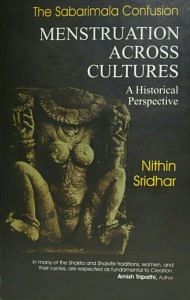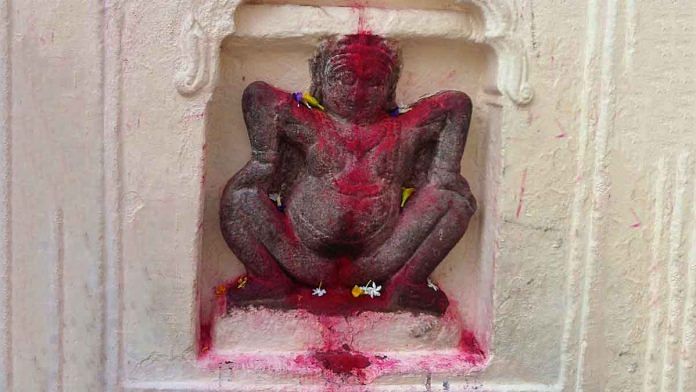Menstrual blood is, in fact, considered pure and sacred, and plays a very important role in certain Tantric rituals.
The association of menstruation with sacredness is reinforced in Tantric practices such as Yoni Puja (worship of the female Yoni), wherein a ritual worship is carried out not only of a woman, but also of her Yoni or Vagina, which is perceived to be a symbol of the Cosmic Yoni from which the entire universe has emerged. Menstrual blood is, in fact, considered pure and sacred, and plays a very important role in these Tantric rituals.
The Yoni Tantra, for example, notes that the Yoni puja must be carried out only in the Yoni which has started menstruating. It says: “What point is there of many words? The yoni which has bled is suitable for worship. Do not worship a yoni which has never bled. Worshipping a yoni which has never bled causes loss of siddhi on every occasion.”
Describing the menstrual blood as a pure and eternal substance, Kaulajnananirnaya of Matsyendranath (Patala 8), says: “‘In Kaula Agama, the five pure and eternal substances are ash, wife’s nectar, semen, menstrual blood and ghee mixed together. In occasional rites and in [the] acts of Kama Siddhi, the great discharge is without doubt and most certainly what one should do in Kaula Agama… One should always consume the physical blood and semen. Dearest One, this is the obligation of the Yoginis and the Siddhas.” The same text (Patala 8) further states about the spiritual and medicinal power of menstrual blood, thus: “A Brahmin goes to heaven by endless washing of the feet and mouth, whereas a person repeatedly making a forehead mark of Kunda, Gola or Udbhava menses destroys various ailments such as leprosy and smallpox and is free from all disease in the same way that a serpent sloughs its skin.” It further notes in Patala 18 that: “‘Blood is the female (Vama) elixir. Mixed with wine and semen, it is the Absolute.”
Another text, Matrikabheda Tantra (Patala 8) describes different kinds of menses thus: “Sri Shankara said: “The first menses appearing in a woman who has lost her virginity is Svayambhu blood. In a maiden born of a married woman and begotten by another man, that which arises is Kunda menses, the substance causing the granting of any desire. Deveshi, a maiden begotten by a widow gives rise to Gola menses, which subdues gods. The menses arising in the first period after a virgin becomes a married woman is the all bewildering Svapushpa.’’
In his introduction to Kaulavalinirnayah of Jnanananda Paramahamsa, John Woodroffe, while summarising the contents of chapter 17 of the text writes: “The text goes on to say that there are people who regard semen and menstrual fluid with disgust (Vicharayet), but they forget that the body by which they hope to attain Liberation is composed of these two forms of matter; that the marrow, bone and tendons have come from the father, and the skin, flesh and blood from the mother. It further says that there is no reason for man’s disgust for excreta or urine, for these are nothing but food or drink which has [sic] undergone some change and contains living creatures and the Brahman substance is not absent therefrom. The purity that man ought to cultivate is that of the mind. All things are pure. It is one’s mentality (Vasana) which is evil.”
Thus, we have enough evidences in the Tantric textual tradition which shows how menstruation is perceived as pure and sacred, and a central element in certain kind of rituals, especially those which involve the worship of the genitals, and of sexual intercourse.
Yoni Tantra, for example, gives this procedure for how Yoni should be worshipped, in the form of a dialogue between Goddess Parvati and her Lord, Mahadeva, and as noted before, only a Yoni which has bled is worshipped. When Parvati asks her husband in what way should a practitioner worship Yoni, which is the essence of the cosmos, the Mahadeva replies thus: “A sadhaka wishing to worship a yoni, which is the form of the cosmos, should cause an erection, and insert it into that thing which is Shakti Herself. The vagina is Mahamaya and the penis is Sadashiva. Worshipping them, one becomes liberated while still alive, there is no doubt of it. One should offer bali, flowers and so forth. If incapable of this, worship with wine, O Durga. One should do pranayama and my six limbed puja in the yoni region. After reciting the mantra [a] hundred times at the base of the yoni, one should rub the linga and the yoni together.”
Similarly, the Bauls of Bengal – a syncretic group of mystic singers and dancers, whose religious beliefs are influenced by Vaishnava, Sakta, Tantric Buddhism, Samkhya, and Sufi belief systems – practice Deha Sadhana (spiritual practice using the body), a form of sexual yoga, wherein sexual energy is transformed into Prema (divine love) and Spiritual ecstasy. The Bauls believe that men and women are abodes of two different aspects of the Divine. The women’s Nir i.e. sexual fluid (literally water) contains one aspect of the divine, which is believed to descend down in the form of a fish during the monthly periods. Similarly, the men’s Kshir i.e. semen (literally milk) is said to contain the other aspect of the divine. The Bauls believe that through the ritual practice of sexual Yoga during menstruation, the ‘fish’ (the feminine aspect of the divine) that ‘swims’ in the menstrual fluid could be united with the Kshir, and a state of Yogic bliss or Ananda can be attained. In other words, the Bauls perform sexual intercourse during menstruation as a means to attain divine bliss and spiritual emancipation. It is important to note that this sexual intercourse indulged as part of Deha Sadhana is purely a devotional act and should not be confused with sexual intercourse indulged in for the sake of sensual pleasure or conception. The importance of menstruation during the Deha Sadhana can also be understood by the fact that the time of monthly periods is called “Mahayoga” (Great Yoga) and the first and the third day of menstruation are designated as “Amavasya” (New Moon) and “Poornima” (Full Moon) respectively.
Even Yoga-upanishad texts like Yoga-Shikha Upanishad, which is among the 108 authentic Upanishads listed in the Muktika Upanishad, describes sexual sadhana during menstruation as “Raja-Yoga”. It says: “There abides in the great spot in the middle of the Yonis of creatures: Rajas (menstrual fluid) resembling the Japa and Bandhuka flowers in colour, well-protected and (representing) the Devi (feminine) principle. By the conjunction of the Rajas with the Retas (of the male organ), (i.e., of Shakti with Shiva), there is what is known as Raja-yoga. From Raja-yoga (the Yogin) shines out after attaining the psychic powers of attenuation and the like.”
Devipuram is a temple in Andhra Pradesh, which is an important center of Devi worship in the Tantric tradition of Srividya. The temple itself has been built in the form of Sri Chakra – the abode of the Supreme Goddess Lalita Tripurasundari, and it contains a Kamakhya Peetham – a naturally formed Yoni. Speaking to Sinu Joseph of ‘Mythri Speaks’, Sri Amritananda Natha Saraswati, the founder of Devipuram and a practitioner of Srividya, said that most priests in his temple were women and that they were all free to stay at the temple during their monthly periods. He further said: “What is pure, we don’t touch. And what we don’t touch, we call it a Taboo. She (a menstruating woman) was so pure, that she was worshipped as a Goddess. The reason for not having a woman go into a temple is precisely this. She is a living Goddess at that time. The energy of the God or Goddess which is there in the Murti will move over to her, and that (the Murti) becomes lifeless, while this (the menstruating woman) is life. So that’s why they were prevented from entering the temple [21].” Thus, the Guruji of Devipuram, clearly associates purity with menstruation and considers menstruating women as living Goddesses, while also highlighting the fact that the practice of menstruating women not being allowed into temples was rooted in the fact that there will be an imbalance in the energy of the temple.
Therefore, it is clear that in the Tantrika tradition, menstruation is a sacred celebration, which is ritually pure, potent with many positive attributes, and is an inseparable aspect of many Tantrika practices. But it is to be noted that most Tantrika practices and the associated worldview, are highly tailor made and their applicability are limited to a particular place, context, rituals, and to competent practitioners of these rituals; not to general society. Yet, despite this limited application, what the texts like Yoni tantra, practices like Deha Sadhana of the Bauls, or the views of the Devipuram Guruji, establish is the fact that Hinduism does not put forward a blanket worldview on any issue. Instead, Hindu tradition and practices are tailor-made based on different situations, goals, competencies, and needs of the people. As a result, menstruation, which is otherwise rightly associated with ritual Ashaucha (because of which sexual intercourse and sacred activities like worship are restricted), becomes associated with ritual Shaucha (purity), sexual intercourse, and worship in the case of Yoni puja, Deha Sadhana and similar other Tantric practices.
 This excerpt was taken with permission from the book ‘Menstruation Across Cultures: A Historical Perspective’ by Nithin Sridhar. It was published by Vitasta Publishing in 2019.
This excerpt was taken with permission from the book ‘Menstruation Across Cultures: A Historical Perspective’ by Nithin Sridhar. It was published by Vitasta Publishing in 2019.







Very nice description of Tantra and rituals inTantra ,being glamorous, Iam very impressed with the Topic.
Very nice description of Tanra and rituals inTantra ,being glamorous.
Sir all this is known that there are different streams of hindu worship. Please note that we cannot superimpose form of one worship of one particular form of deity on another. There are different ways and each way is for a person pursuing a different path. The paths of satva, rajas and tamas, all of them can lead to moksha. But nowadays courts want to put their foot on where they better not tread and like to see hinduism as a monolithic religion.